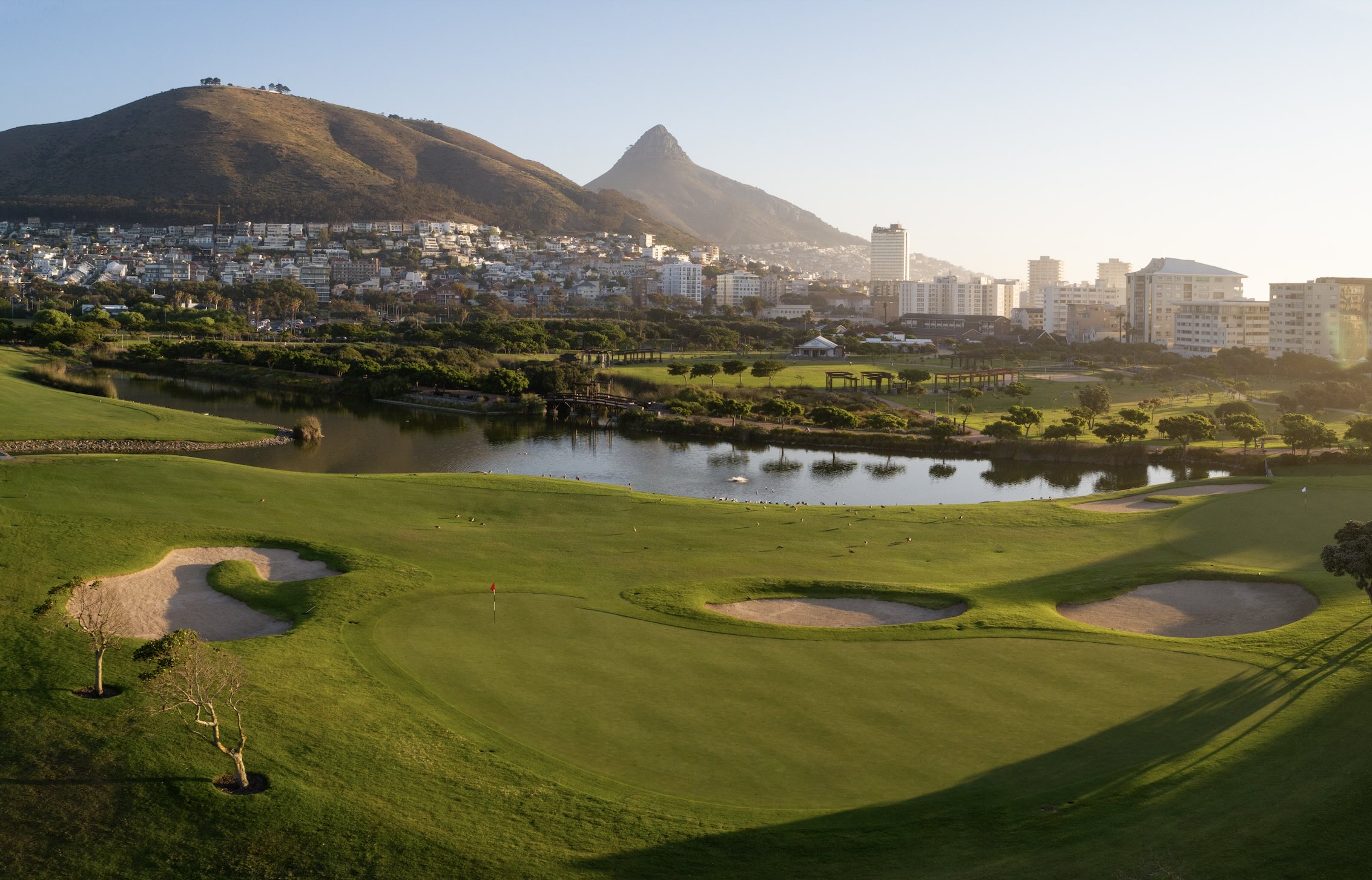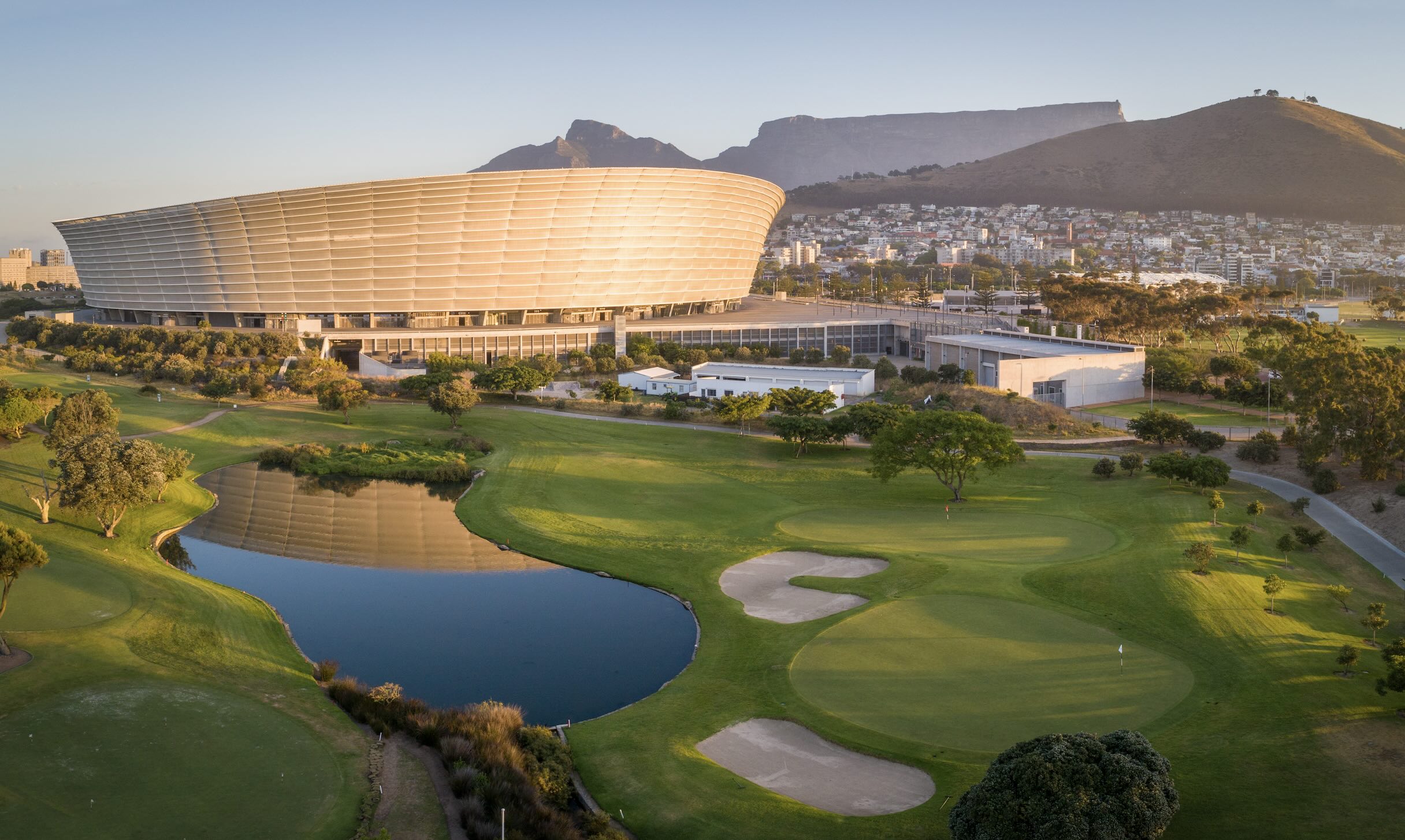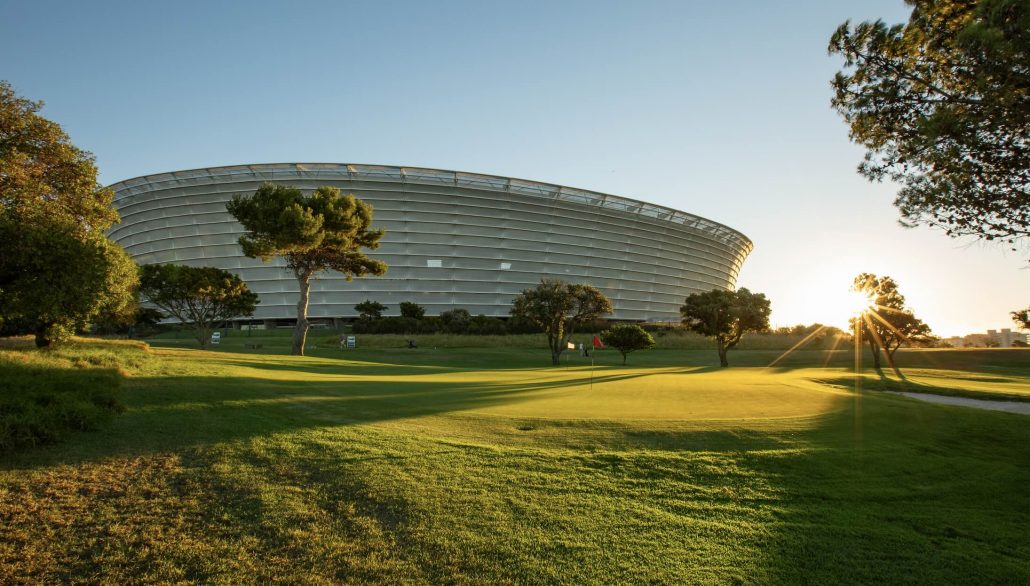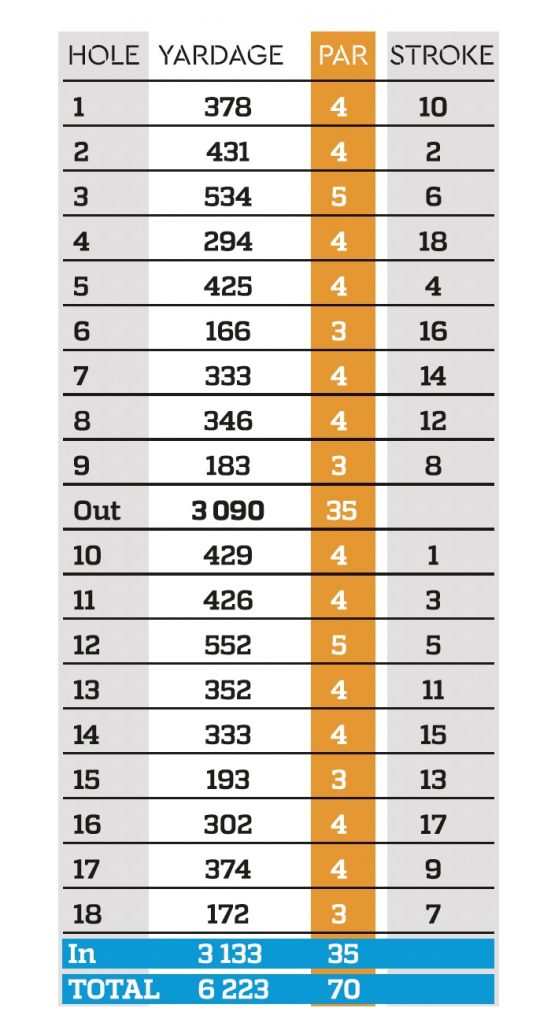Set in a world-class city, its location is primed for travellers looking for a quick round with breathtaking backdrops surrounded by five-star hotels, dining options and activities, writes MARK SAMPSON.
Metropolitan Golf Club may not be set in a large natural forest, have a massive coastal vista from each hole, nor possess a full 18 holes. What it does have is a location in the middle of Cape Town, flanked on the northern side by the Atlantic Ocean and majestic views of Lion’s Head and Table Mountain in the south.
Established in 1895, Metropolitan boasts being the second-oldest club in Cape Town behind only Royal Cape. Like many courses of its age, it has changed location on one occasion with the building of Cape Town Stadium for the World Cup football tournament. Construction of the stadium began in 2007.
It was around this time designer Mark Muller was commissioned to use an alternative space offered by the city to create a ‘new’ course.
The clubhouse remained in place from the original course, not massive compared to many of the more modern clubhouses but clever usage of the space provides everything you need at a course.
Downstairs you will find the relatively new pro shop with all the current stock of golf regalia. The halfway house flows out from a small canteen to an outside covered eating area. The rest of the downstairs area is utilised by admin offices and the change rooms.
Upstairs is primarily the bar/restaurant area spilling out onto the patio area overlooking the 9th/18th green, Cape Town Stadium and Table Mountain. A great location for sunset drinks.
During remodelling, the greens were changed to bent grass and were crafted with beautiful natural slopes. For club champs and tournaments, the greens can really be increased to a high speed on the stimpmeter, challenging the most soft-handed of putters.
The available space has been well utilised, getting the most into a smaller area. Having 14 greens and 18 tee boxes, it makes for an interesting round.
One is lulled into a false sense of security thinking a shorter par-70 course of 6,223m will be a pushover. Nothing could be further from the truth.
The 14 greens are skilfully contoured and having bent grass, they run pure and smooth. Many of the greens are also rather large, bringing in the opportunity for ample three-putts.
Granted, the fairways are forgiving and the rough is manageable, but the course nevertheless has several sneaky tricks up its sleeve.
You’d be forgiven for thinking length would be compromised on this layout. However, having a par four of 431m and a par five of 534m in the first three holes quashes that expectation very quickly.
The course is divided into two sides with eight holes wedged between the clubhouse and Cape Town Stadium and the remaining holes accessed by a short walk under the access road to the 1st/10th tee box.
Wind, as with most coastal courses, also plays a role in the scoring average. The eight holes beside the clubhouse in particular are influenced by the stadium structure. Oval in shape, it can make for difficult reading of the wind strength and direction.
The opening trio of holes requires a swing that is already warmed up and in the groove.
The 1st, a par four of 378m, has out of bounds down the entire right side; the famous Hamilton Sea Point Rugby Football Club, the oldest in the country, has received many a pulled drive. Pushing the drive a little right is never a bad play on the opening hole, leaving a mid-iron into the green. Sloping from back to front and a bunker short right, it can prove to be a challenge into the prevailing south-wester.
Played as the 10th, you can expect to play to a separate well-bunkered green. At 429m it is a monster and appropriately the stroke one.
At 431m, the stroke-two 2nd hole leaves you with a nerve-racking approach. Often influenced by a crosswind as well as having a water hazard cutting left-to-right across the fairway, you’d do well to find the green in two. For this reason, higher handicappers are well advised to lay up to their favourite distance, going for an up-and-down to take out the chance of a double-bogey. The green is slightly elevated from the fairway, increasing the difficulty of finding it in two.
Played as the 11th, you can expect to play to a separate green, this time on the right of the water hazard. At 426m, its stroke-three rating is well earned.
Turning back towards the ocean, the 3rd is a monstrous par five of 534m. Although completely straight, it has an unnerving fairway which tapers as you near the hole. At the same time, water hazards on each side of the fairway increase the difficulty of staying dry. For those laying up, you really need a precision iron to find the fairway, especially with wind coming from the side. Longer hitters can try to find the surface in two; however, bunkers short right and two back left have ended many a birdie attempt.

When played as the 12th it is slightly lengthier at 552m with the approach primarily over a water hazard to a separate green.
The 4th offers some respite for the shorter hitters as its 294m length is often aided by the south-wester. Multiple bunkers leading up to the hole, and greenside, need to be avoided. The diminutive green of this stroke-18 hole, if found in two, offers a good birdie opportunity.
At the second playing of this hole, it plays to a length of 352m to a large tiered green with bunkers splashed across the fairway on approach.
The 5th, once again, will leave a testing long-iron into the green. At 425m and often into the wind, it is no wonder this is the stroke four aptly named ‘Mouille Point’ as it runs parallel to the main road in the suburb of the same name. Along the left side is a water hazard and with the fairway sloping towards it, it’s no wonder many of the members opt for a slightly pushed drive towards the safety of the 1st fairway. A lengthy shared green can be expected on this hole so be sure on club selection otherwise you can expect a testy two-putt.
When playing it as the 14th, the length is reduced to 333m illustrating both variation of tee boxes but also the depth of this green.
Heading back to the side of the clubhouse the first par three of the day awaits. Again, another shared green with a trio of bunkers protecting it, the 166m hole requires a well-struck mid-iron to the heart of the green.
When played as the 15th, the tee is set much further back increasing the length from 166m to 193m. This produces a challenging shot when the south-easter is blowing.
The 7th is another relatively short par four rising from tee to green. It’s very much a risk-and-reward hole swinging from right to left. The longer hitter can get close to the surface in one but needs to take a line near to the out-of-bounds area and a large waste bunker. The prudent play is a long-iron to the wider part of the fairway and finding the green in two with a short-iron.
Playing it as the 16th, the length changes from 333m to 302m to the shared green, so slightly shorter to further entice the long hitters.
The Met is a flat layout, with little change in elevation to concern club selection. The 8th tee is the ‘highest’ point on the course and plays back down to the green. The tee is placed right at the base of Cape Town Stadium making the wind difficult to read on this blind tee shot. The fairway slides from right to left and is generous in width. That said, it is also protected by some of the heaviest rough and trees on the course. The shared green is not large nor contoured.
As the 8th it plays to 346m and the 17th, 374m.
The closing 9th is a par three of 183m to a smallish green protected by a bunker short right and tree left. The second playing of this hole is to a separate green which is also the signature hole of the course (see below).
Although tightly squeezed in, ‘the Met’ – as it is affectionately known – has ample practice facilities. A large putting area between the clubhouse and the 8th/17th green can be utilised to gain an idea of the pace and contouring of the greens, while there’s another smaller putting/chipping area beside the 1st/10th tee. Warm-up nets can also be found near the 1st to get the swing going.
Very few large cities have a golf course near the heart of the CBD in such picturesque surroundings. This uniqueness is further amplified by the interesting layout of the course with shared and single greens and a variety of tee boxes.
Add to that the varying wind changes experienced in Cape Town and you can expect each round to be a new challenge.
The most unique thing is the serenity you experience on the course, situated in a greenbelt of the city, while surrounded by the hustle and bustle of Cape Town. It’s a must-play course.
SIGNATURE HOLE
18th hole, par three, 172m

It is not that common to have a par three as a closing hole. The uniqueness of this hole is further influenced by being set besides one of the world’s most iconic stadiums and Table Mountain being one of the world’s natural wonders.
At 172m in length and slightly downhill, it is easy not to take this hole seriously. It has, however, spoilt many a good round by being underestimated.
Often playing into the wind, with an elevated tee, you need to be sure of club selection. Not only to reach the hole but also not putting too much spin on the ball. This needs careful consideration as the green slopes strongly from back to front and is protected by a water hazard in the front.
During tournament play, the fringes are cut short, leaving zero hope of the ball stopping prior to entering a watery grave. The stroke seven is also protected by two bunkers on either side of the front as well as out of bounds on the right.
Final consideration needs to be made of the wind strength and direction, which, as mentioned, can be significantly influenced by the proximity of the stadium.
Standard procedure is therefore required to find the putting surface in windy conditions.
Taking an extra club and making a nice solid swing, while placing the ball back in the stance, are all good practice. Ignoring the location of the flag and targeting the centre of the green is highly recommended.
The green is not that large and therefore if the surface is found, a two-putt par is on the cards. This green has, however, got more slope than most, so putting downhill, towards the water, should be done with soft hands.
Before departing for the historical clubhouse be sure to take one last look back towards the tee, stadium, Signal Hill and Table Mountain peeking out in the distance.
GREENFEES
Members: R205/9 holes R310/18 holes
Scholars: R75/9 R110/18
Affiliated Guests: R345/9 R515/18
Non-affiliated Guests: R410/9 R630/18
Golf Cart Visitors: R265/9 R420/18
ADDRESS
Fritz Sonnenberg Road
Mouille Point
Cape Town
ROAD DISTANCES
George: 438km
Bloemfontein: 1,003km
Durban: 1,637km
Johannesburg: 1,399km
Gqeberha: 752km
CONTACT DETAILS
Email: [email protected]
Website: www.metropolitangolfclub.co.za
Phone: (021) 430 6011
– This article first appeared in the May 2024 issue of Compleat Golfer magazine.
Photos: Mark Sampson










